Don't understand the lingo? You're sure to be "in the dark." Use the following glossary to shed light on commonly used lighting industry terms.
| Term | Definition |
| ANSI Code |
A three letter system that has been devised to describe lamps of different manufacture but the same application. The letters have no relationship to lamp description, but the same letters always designate the same type of lamp. Some of the application parameters they define are wattage, base type envelope size, and light center length. |
| American National Standards Institute (ANSI) |
A consensus-based organization which coordinates voluntary standards for the physical, electrical and performance characteristics of lamps, ballasts, luminaires and other lighting and electrical equipment. |
| Amperes |
A measure of electrical current. In incandescent lamps, the current is related to voltage and power as follows: Current (Amps) = Power (Watts) / Voltage (Volts). In miniature lamps, it is the approximate current which the lamp will draw at design volts. |
| Arc |
The light caused by an electrical discharge between two electrodes in a gas such as xenon, argon, or air. The first usable arc as a practical light source was developed in 1809 by Sir Humphrey Davy. |
| Ballast |
An auxiliary piece of equipment required to start and to properly control the flow of current to gas discharge light sources such as fluorescent and high intensity discharge (HID) lamps. |
| Ballast Factor (BF) |
This is the percentage of a lamp's rated lumen output that can be expected when operated on a specific, commercially available ballast. For example, a ballast with a ballast factor of 9.93 will result in the lamp's emitting 93% of its rated lumen output. A ballast with a lower BF results in less light output and also generally consumes less power. |
| Base Type |
The base is the end of the lamp that fits into the receptacle connected to the electrical supply. Bases provide electrical contact to the lamp and, in most cases, also support the lamp in the fixture. There are many types of bases used in lamps, screw bases being the most common for incandescent and HID lamps, while bipin bases are common for linear fluorescent lamps.
Large Lamp Bases
Here is a list of some common base types for large lamps.
- Incandescent
- Medium
- Mogul
- Candelabra
- Intermediate
- DC Bayonet
- Screw Terminal
- Disc
- Medium Side Prong
- 3 Prong
- Halogen
- Medium
- Medium Skirt
- Medium Nickle Plated
- Mogul
- GX5.3
- GU5.3
- G4
- GY6.35
- Mini Candelabra
- DC Bayonet
- R7s
- Screw Terminal
- Fluorescent
- Medium Bi-Pin
- Miniature Bi-Pin
- Mogul Bi-Pin
- Recessed Double Contact
- Single Pin
- High Intensity Discharge (HID)
- Medium
- Medium Skirt
- Medium Nickle Plated
- Mogul
- G8.5
- G12
- GU6.5
- GX10
- PGJ5
- PGZ18
- RX7s
- Compact Fluorescent
- Medium
- G23-2
- G24d-1
- G24d-2
- G24d-3
- 2G11-4
- G24q-1
- G24q-2
- G24q-3
- GR8-2
- GR10q-3
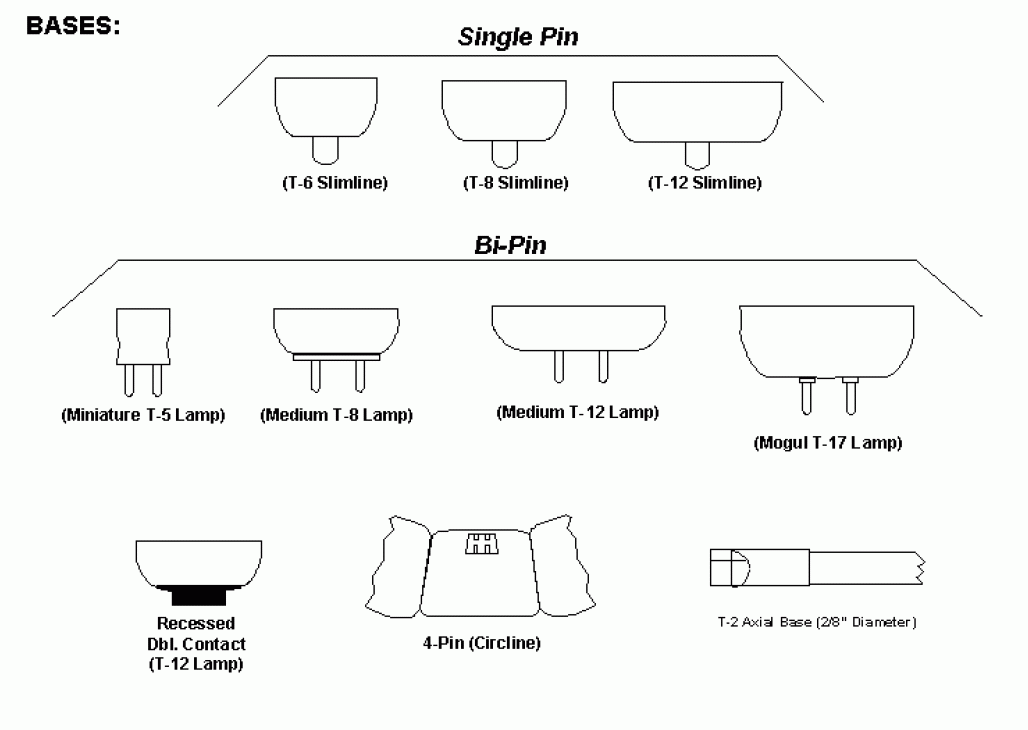
Miniature Bases
For miniature and subminiature lamps, bayonet or wedge base types are generally preferred over screw types when vibration is present. In addition, wedge bases reduce socket size and complexity. Flanged or collared types are usually associated with requirements for filament location.
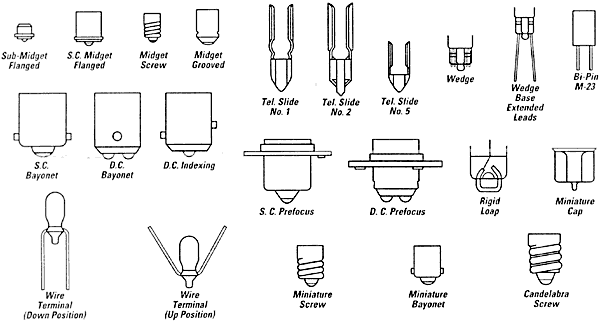
|
| Beam Angle |
The angular dimension of the cone of light from reflectorized lamps (such as R and PAR types) encompassing the central part of the beam out to the angle where the intensity is 50% of maximum. The beam angle sometimes called "beam spread" is often part of the ordering code for reflectorized lamps. Example: The 50PAR30/HIR/NFL25 is a 50 watt PAR30 narrow flood lamp with a beam angle of 25 degrees. See also Field Angle. |
| Beam Pattern |
The complete shape of the beam, as defined in the general sense. It includes any realistic or abstract patterns introduced into the beam as well as any apparatus that alters the contour of the beam. |
| Blacklight |
A luminaire with a beam whose wavelengths are too short to be visible, i.e., 320 to 380 nm. These ultraviolet wavelengths excite fluorescent materials, paints, etc., in theatrical applications. |
| Bulb Shape |
The shape of a bulb is identified by a letter or letters followed by its maximum diameter, expressed in eighths of an inch. For example, a R40 has a maximum diameter of 40 eighths of an inch which equals 5 inches.
Various bulb shapes are as follows:
| B |
Blister |
|
R |
Reflector |
| G |
Globular |
|
RP |
Rounded Parabolic |
| GT |
Globular-Tubular |
|
S |
Straight-sided |
| PAR |
Parabolic Aluminized Reflector |
|
T |
Tubular |
| |
|
|
TL |
Tubular, Lens end |
|
|
| Candela (cd) |
The measure of luminous intensity of a source in a given direction. The term has been retained from the early days of lighting when a standard candle of a fixed size and composition was defined as producing one candela in every direction. A plot of intensity versus direction is called a candela distribution curve and is often provided for reflectorized lamps and for luminaires with a lamp operating in them. |
| Candlepower |
An obsolete term for luminous intensity; current practice is to refer to this simply as candelas. See Candela. For miniature lamps, the rating shown is the mean spherical candlepower produced at design voltage. Candlepower is increased rapidly with an increase of applied voltage and conversely is reduced rapidly with a reduction of applied voltage. Should a lamp be operated at low voltage to take advantage of increased life, there will be an inevitable loss of candlepower. |
| Center Beam Candlepower (CBCP) |
Refers to the luminous intensity at the center of the beam of a blown or pressed reflector lamp (such as a PAR lamp). Measured in candelas. See also Candela. |
| Ceramic Metal Halide (CHM) |
A Type of metal halide lamp that uses a ceramic material for the arc tube instead of glass quartz, resulting in better color rendering (greater than 80 CRI) and improved lumen maintenance. |
| Coefficient of Utilization |
In general lighting calculations, the fraction of initial lamp lumens that reach the work plane. CU is a function of luminaire efficiency, room surface reflectances and room shape. |
| Cold Start |
A term used to describe the ignition of a cold arc lamp, i.e., a lamp that has not been electrified for a relatively long period of time. |
| Color Rendering Index (CRI) |
An international system used to rate a lamp's ability to render object colors. The higher the CRI (based upon a 0-100 scale) the richer colors generally appear. CRI ratings of various lamps may be compared, but a numerical comparison is only valid if the lamps are close in color temperature. CRI differences among lamps are not usually significant (visual to the eye) unless the difference is more than 3-5 points. |
| Color Temperature (Correlated Color Temperature (CCT)) |
A number indicating the degree of "yellowness" or "blueness" of a white light source. Measured in Kelvins, CCT represents the temperature an incandescent object (like a filament) must reach to mimic the color of the lamp. Yellowish-white ("warm") sources, like incandescent lamps, have lower color temperatures in the 2700K - 3000K range; white and bluish-white ("cool") sources, such as cool white (4100K) and natural daylight (6000K), have higher color temperatures. The higher the color temperature the whiter, or bluer, the light will be. |
| Compact Fluorescent Lamp (CFL) |
The general term applied to fluorescent lamps that are single-ended and that have smaller diameter tubes that are bent to form a compact shape. Some CFLs have integral ballasts and medium or candelabra screw bases for easy replacement of incandescent lamps.
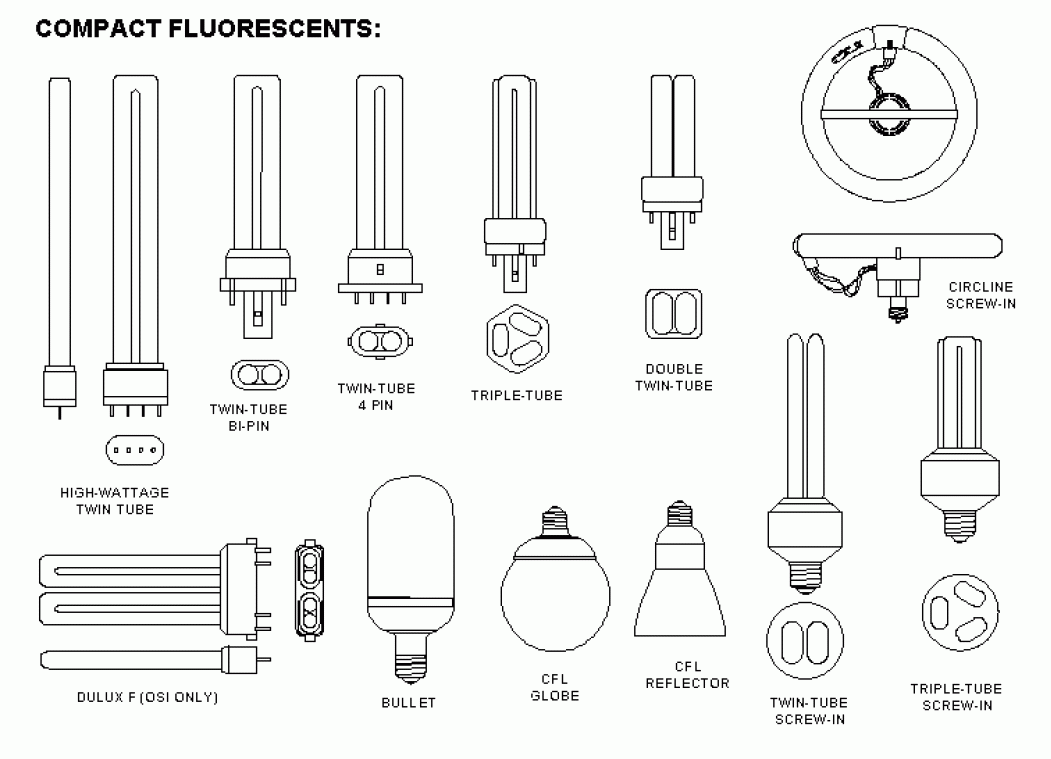
|
| Design Volts |
The socket voltage for which the lamp will draw at design volts. |
| Electromagnetic Spectrum |
A continuum of electric and magnetic radiation that can be characterized by wavelength or frequency. Visible light encompasses a small part of the electromagnetic spectrum in the region from about 380 nanometers (violet) to 770 nanometers (red) by wavelength. |
| Electronic Ballast |
A short name for a fluorescent high frequency electronic ballast. Electronic ballasts use solid state electronic components and typically operate fluorescent lamps at frequencies in the range of 25-35 kHz. The benefits are: increased lamp efficacy, reduced ballast losses and lighter, smaller ballasts compared to electromagnetic ballasts. Electronic ballasts may also be used with HID lamps. |
| Elliptical Reflector (ER) Lamp |
An incandescent lamp with a built-in elliptically-shaped reflecting surface. This shape produces a focal point directly in front of the lamp which reduces light absorption in some types of luminaires. It is particularly effective at increasing the efficiency of baffled downlights. |
| Field Angle |
The angular dimension of the cone of light from reflectorized lamps (such as R and PAR types) encompassing the central part of the beam out to the angle where the intensity is 10% of maximum. |
| Filament |
The wire inside an incandescent lamp envelope that glows and emits light when heated, i.e., when electricity passes through it. Filament configurations are identified by letters and a suffix number (or number and letter) indicating the shape of the filament and the number of any supports.
Large Lamp Filaments
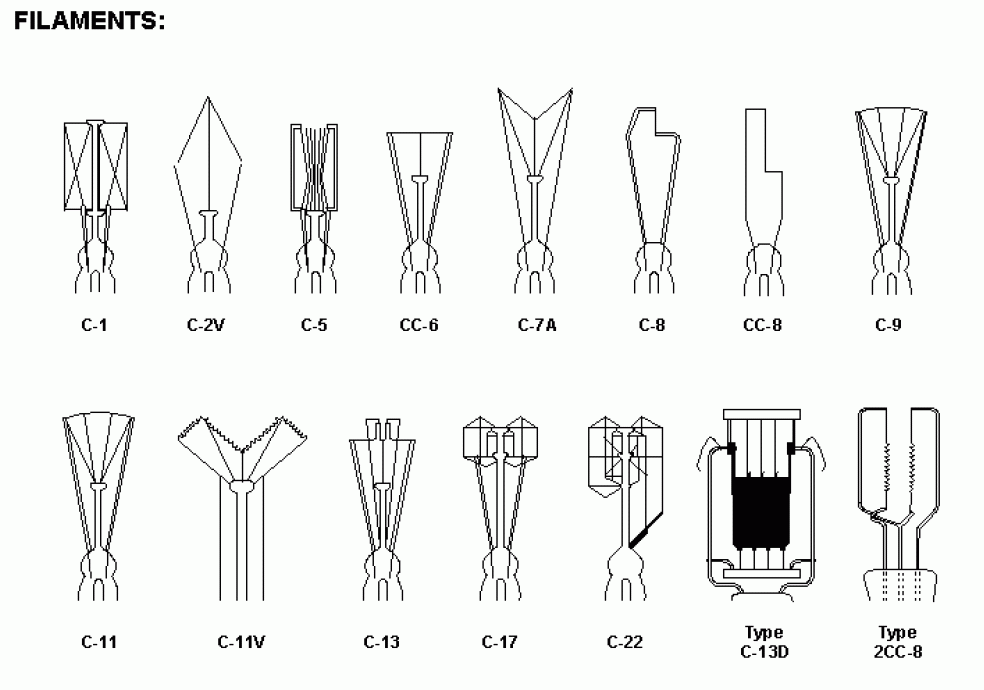
Miniature Filaments
Filaments for miniature and subminiature lamps may be a straight wire (S), a coil (C), or a coiled coil (CC). Coiling the filament wire effectively shortens the filament length so that smaller bulbs can be used. In addition, in gas-filled lamps, coiling the wire reduces thermal losses and increases efficiency.
Tungsten is almost universally used as lamp filament material because of its high melting point at incandescence. The number following the coil identification letter(s) denotes the arrangement of the filament on the supports.
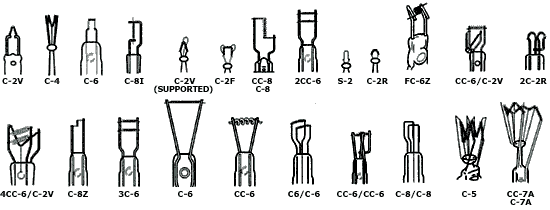
|
| Fluorescent Lamp |
A high efficiency lamp utilizing an electric discharge through low pressure mercury vapor to produce ultra-violet (UV) energy. The UV excites phosphor materials applied as a thin layer on the inside of a glass tube which makes up the structure of the lamp. The phosphors transform the UV to visible light. |
| Footcandle (fc) |
A unit of illuminance or light falling onto a surface. It stands for the light level on a surface one foot from a standard candle. One footcandle is equal to one lumen per square foot. See also Lux. |
| Full Spectrum Lighting |
A marketing term, typically associated with light sources that are similar to some forms of natural daylight (5000K and above, 90+ CRI), but sometimes more broadly used for lamps that have a smooth and continuous color spectrum. |
| Gas Filled |
Gas filled lamps use an inert gas to protect the filament during operation. In most automotive lamps, the gas most used is a mixture of 88% argon and 12% nitrogen. The pressure of the fill gas at room temperature is about 3/4 of an atmosphere.
The use of a fill gas reduces the net rate of tungsten evaporation by several orders of magnitude, so that little blackening of the bulb occurs during the life of the lamp. Since the net evaporation rate in gas is less than in a vacuum, the filament can be operated at a higher temperature for the same life. For this reason , gas filled lamps are more efficient than vacuum lamps.
The blackening that does occur is usually confined to the top of the bulb because of convection currents produced during operation. To avoid "water cycle" and premature blackening, "getters" are usually used to chemically or physically bind contaminants and assure a "clean" fill gas. Purity of the gas fill initially and during operation is critical in gas filled lamps. |
| Halogen Lamp |
A halogen lamp is an incandescent lamp with a filament that is surrounded by halogen gases, such as iodine or bromine. Halogen gases allow the filaments to be operated at higher temperatures and higher efficacies. The halogen participates in a tungsten transport cycle, returning tungsten to the filament and prolonging lamp life.
Halogen lamps, in addition to being gas filled, have a gaseous halogen compound added to the gas fill. The halogen compound constitutes a small portion of the fill gas and must be accurately controlled. The quantity used is on the order of 100 parts per million of fill gas and is usually a bromine compound. Its purpose is to prevent any blackening of the bulb by returning evaporated tungsten back to the filament through a "halogen cycle". Too little halogen permits blackening of the bulb to occur. Too much halogen destroys the tungsten filament.
Since with proper operation of the "halogen cycle" no blackening occurs, the bulb can be smaller than what is normally used in regular gas filled lamps. With smaller envelopes, higher molecular weight inert gasses and higher fill pressures are practical. Krypton is generally used in automotive halogen lamps and the fill pressure at room temperature is approximately 5 atmospheres.
The higher molecular weight gas and higher fill pressure permits operation of the filament at even higher temperatures than regular gas filled lamps, so that for the same life, halogen lamps have the highest efficiency of all miniature lamps.
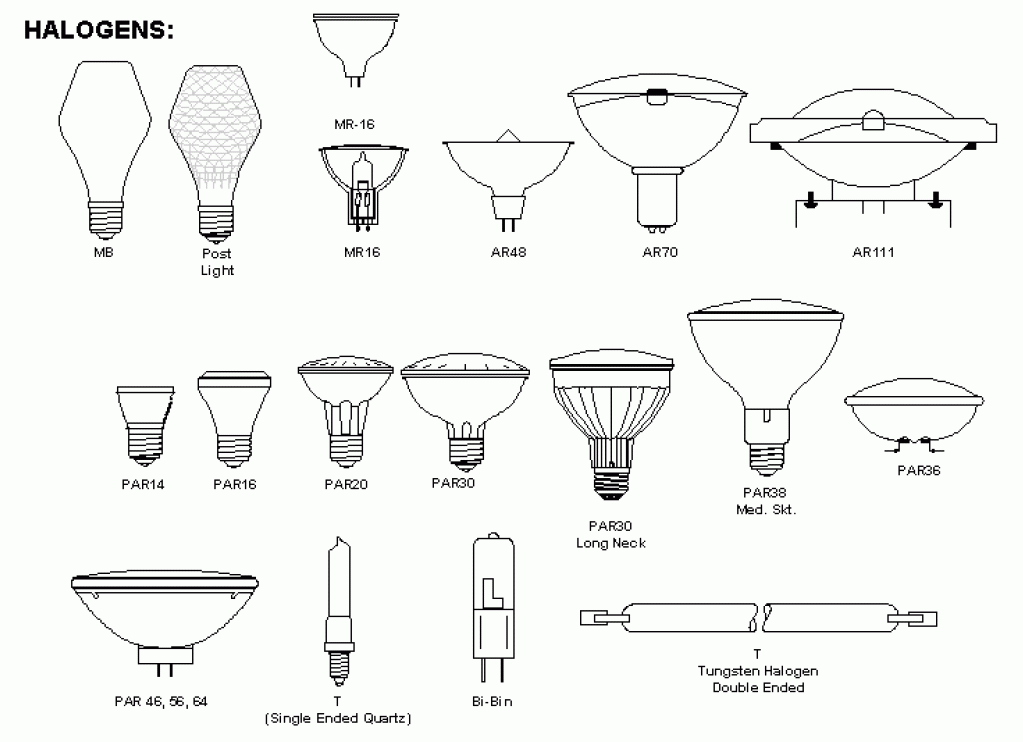
|
| High Intensity Discharge (HID) Lamp |
The family of HID lamps includes the following lamp types: mercury vapor, metal halide, high-pressure sodium and less common, xenon short-arc lights. The light-producing element of these light types is a well-stabilized arc discharge contained within a refractory envelope, or arc tube.
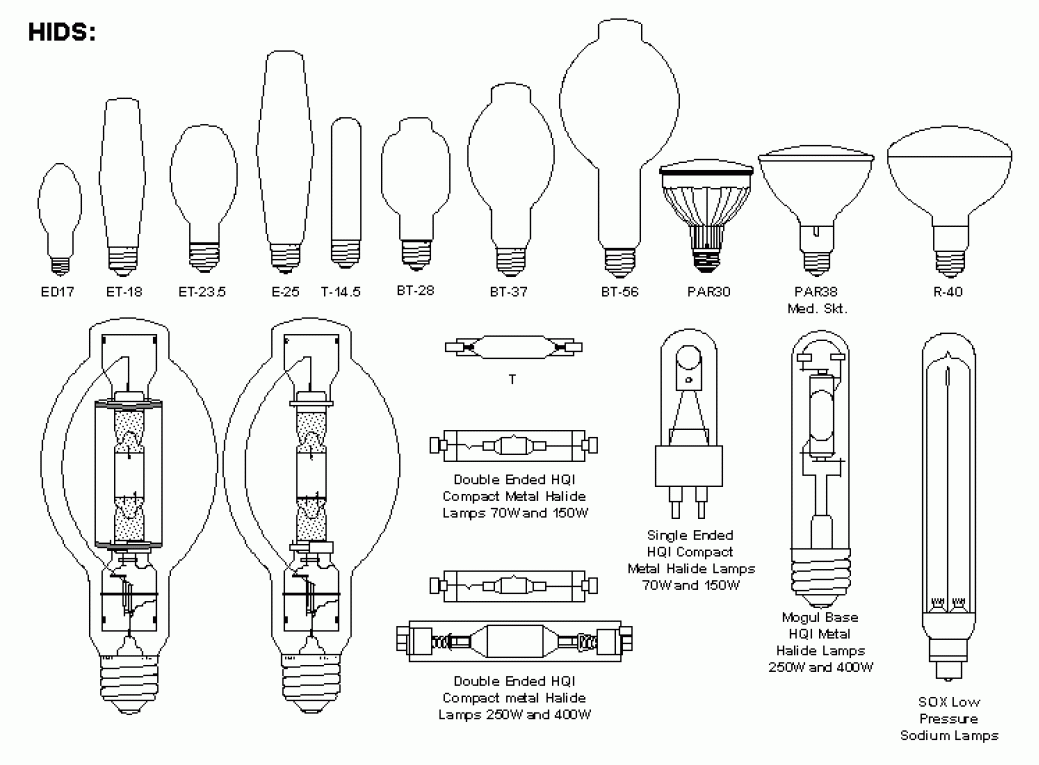
|
| High-Pressure Sodium (HPS) Lamp |
HPS lamps are high intensity discharge light sources that produce light by an electrical discharge through sodium vapor operating at relatively high pressures and temperatures. |
| Illuminance |
The "density" of light (lumens/area) incident on a surface; i.e. the light level on a surface. Illuminance is measured in footcandles for lux. |
| Incandescent Lamp |
A light source that generates light utilizing a thin filament wire (usually of tungsten) heated to white heat by an electric current passing through it.
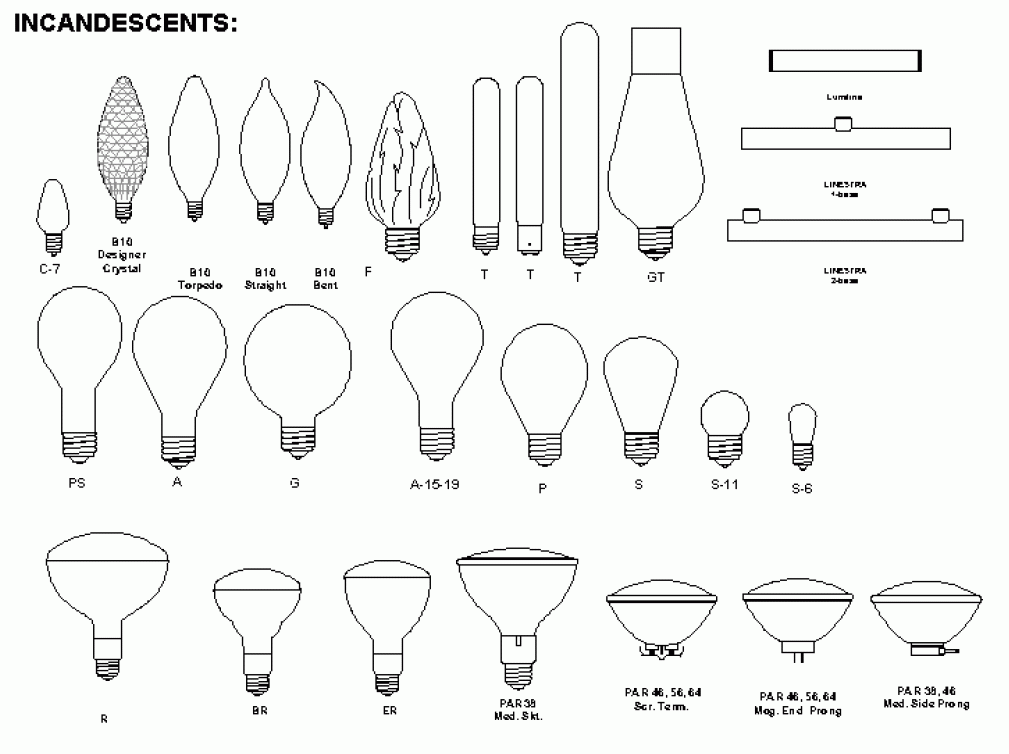
|
| Induction Lighting |
Gases can be excited directly by radio-frequency or microwaves from a coil that creates induced electromagnetic fields. This is called induction lighting and it differs from a conventional discharge, which uses electrodes to carry current into the arc. Induction lamps have no electrodes inside the chamber and generally, therefore, have longer life than standard lamps. |
| Infrared Radiation |
Electromagnetic energy radiated in the wavelength range of about 770 to 1,000,000 nanometers. Energy in this range cannot be seen by the human eye, but can be sensed as heat by the skin. |
| Instant Start |
A type of ballast designed to start fluorescent lamps as soon as the power is applied. Most T8 fluorescent lamps are being operated on electronic instant-start ballasts. Slimline fluorescent lamps operate only on instant start circuits. |
| Kilowatt (kW) |
A measure of electrical power equal to 1000 watts. |
| Kilowatt Hour (kWh) |
The standard measure of electrical energy and the typical billing unit used by electrical utilities for electricity use. A 100-watt lamp operated for 10 hours consumes 1000 watt-hours (100 x 10) or one kilowatt-hour. If the utility charges $.10/kWh, then the electricity cost for the 10 hours of operation would be 10 cents (1 x $.10). |
| LED (Light Emitting Diode) |
LEDs are based on the semiconductor diode. When the diode is switched on, electrons are able to recombine with holes and energy is released in the form of light. This effect is called electroluminescence and the color of the light is determined by the energy gap of the semiconductor. The LED is usually small in area (less than 1 mm2) with integrated optical components to shape its radiation pattern and assist in reflection.
LEDs present many advantages over traditional light sources including lower energy consumption, longer lifetime, improved robustness, smaller size and faster switching. However, they are relatively expensive and require more precise current and heat management than traditional light sources.
Applications of LEDs are diverse. They are used as low-energy replacements for traditional light sources in well-established applications such as indicators and automotive lighting. The compact size of LEDs has allowed new text and video displays and sensors to be developed, while their high switching rates are useful in communications technology.
Sunray LED Products |
| Lamp |
The term used to refer to the complete light source package, including the inner parts as well as the outer bulb or tube. "Lamp", of course, is also commonly used to refer to a type of small light fixture such as a table lamp. |
| Lampholder |
The electrical device that supports a lamp in a luminaire, and generally contains the contacts that make the electrical connection to the contacts of the lamp base. |
| Life |
See Rated Life. |
| Light |
Radiant energy that can be sensed or seen by the human eye. Visible light is measured in lumens. |
| Light Center Length (LCL) |
The distance between the center of the filament, or arc tube, and a reference plane - usually the bottom of the lamp base.
LCL is measured from the geometric center of the lighted filament to that part of the base listed below:
| Double Contact (DC) Bayonet |
Top of base pin |
| Double Contact Index |
Top of lower pin |
| Midget Bi-Pin Base |
Flat bottom of base |
| Midget Grooved Base |
Center of groove |
| Midget Flanged Base |
Top of the flange |
| Miniature Bayonet |
Top of base pin |
| Screw Bases |
Bottom of end contact |
| Single Contact (SC) Midget Flange |
Top of flange |
| Single Contact Miniature Flanged |
Top of bosses in flange |
| Single Contact or Double Contact Prefocus |
Bottom of indentations on prefocusing collar |
|
|
| Lumen |
A measure of luminous flux or quantity of light emitted by a source. For example, a dinner candle provides about 12 lumens. A 60-watt Soft White incandescent lamp provides 840 lumens. |
| Lumen Maintenance |
A measure of how well a lamp maintains its light output over time. It may be expressed numerically or as a graph of light output vs. time. |
| Luminaire |
A complete lighting unit consisting of a lamp (or lamps), ballast (or ballasts) as required together with the parts designed to distribute the light, position and protect the lamps and connect them to the power supply. A luminaire is often referred to as a fixture. |
| Luminance |
A photometric measure of "brightness" of a surface as seen by the observer, measured in candelas per square meter. |
| Luminare Efficiency |
The ratio of total lumens emitted by a luminaire to those emitted by the lamp or lamps used in that luminaire. |
| Luminous Efficacy |
The light output (lumens) of a light source divided by the total power input (watts) to that source. It is expressed in lumens per watt. |
| Lux (lx) |
A unit of illuminance or light falling onto a surface. One lux is equal to one lumen per square meter. Ten lux approximately equals one footcandle. See also Footcandle. |
| Maximum Overall Length (MOL) |
The end-to-end measurement of a lamp, expressed in inches or millimeters. This dimension represents the overall length of the lamp from the top of the glass to the bottom of the base. |
| Mean Lumens |
The average light output of a lamp over its rated life. Based on the shape of the lumen depreciation curve, for fluorescent and metal halide lamps, mean lumens are measured at 40% of rated lamp life. For mercury, high pressure sodium and incandescent lamps, mean lumen ratings refer to lumens at 50% of rated lamp life. See Lumen Maintenance. |
| Mercury Lamp |
A high-intensity discharge light source operating at a relatively high pressure (about 1 atmosphere) and temperature in which most of the light is produced by radiation from excited mercury vapor. Phosphor coatings on some lamp types add additional light and improve color rendering. |
| Metal Halide Lamp |
A high-intensity discharge light source in which the light is produced by the radiation from mercury, plus halides of metals such as sodium, scandium, indiu, and dysprosium. Some lamp types may also utilize phosphor coatings. |
| Minatures / Miniature Lamp |
The term miniature lamp applies to units ranging in size from the so-called "grain of wheat" lamps to automotive headlights. It is not as much indicative of physical size as of low operating voltage - rarely more than 28 volts and often as little as 1.5 or 2.5 volts.
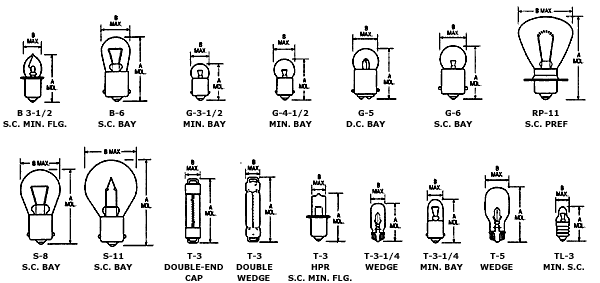
Sunray Lighting Miniature Catalog
Sunray Lighting Product Listing (2004) |
| Nanometer |
A unit of wavelength equal to one billionth of a meter. |
| PAR Lamp |
PAR is an acronym for parabolic aluminized reflector. A PAR lamp, which may utilize either an incandescent filament, a halogen filament tube or a HID arc tube, is a precision pressed-glass reflector lamp. PAR lamps rely on both the internal reflector and prisms in the lens for the control of the light beam. |
| Phosphor |
An inorganic chemical compound processed into a powder and deposited on the inner glass surface of fluorescent tubes and some mercury and metal-halide lamp bulbs. Phosphors are designed to absorb short wavelength ultraviolet radiation and to transform and emit it as visible light. |
| Power Factor (PF) |
A measure of the phase difference between voltage and current drawn by an electrical device, such as a ballast or motor. Power factors can range from 0 to 1.0 with 1.0 being ideal. Power factor is sometimes expressed as a percent. Incandescent lamps have power factors close to 1.0 because they are simple "resistive" loads. The power factor of a fluorescent and HID lamp system is determined by the ballast used. "High" power factor usually means a rating of 0.9 or greater. Power companies may penalize users for using low power factor devices. |
| Preheat Circuit |
A type of fluorescent lamp-ballast circuit used with the first commercial fluorescent lamp products. A push button or automatic switch is used to preheat the lamp cathodes to a glow state. Starting the lamp can then be accomplished using simple "choke" or reactor ballasts. |
| Rapid Start Circuit |
A fluorescent lamp-ballast circuit that utilizes continuous cathode heating, while the system is energized, to start and maintain lamp light output at efficient levels. Rapid start ballasts may be either electromagnetic, electronic or of hybrid design. Full-range fluorescent lamp dimming is only possible with rapid start systems. |
| Rated Life |
For most lamp types, rated lamp life is the length of time of a statistically large sample between first use and the point when 50% of the lamps have died. It is possible to define "useful life" of a lamp based on practical considerations involving lumen depreciation and color shift.
Rated life is not guaranteed life and does not necessarily represent service life expectancy. Rated life, along with rated amperes at design volts, is a factor establishing the laboratory efficiency of a lamp. It is useful only as an index of comparative longevity of various lamps.
The life of an incandescent filament is voltage sensitive. A 10% increase in applied voltage will reduce the filament life to only 30% of its design value, while a 10% decrease in applied voltage will multiply the design life by a factor of approximately three. It is often feasible to "derate" an incandescent lamp for the sake of increased life. |
| Reflector Lamp (R) |
A light source with a built-in reflecting surface. Sometimes, the term is used to refer specifically to blown bulbs like the "R" and "ER" lamps; at other times, it includes all reflectorized lamps like PAR and MR |
| Resistance |
The resistance of tungsten increases with its temperature, and as its applied voltage is increased a given tungsten filament will become hotter. Therefore, at elevated voltages, the rate of current change is less than at reduced voltages. This characteristic sometimes makes tungsten filament lamps useful as circuit ballasts. |
| Scotopic/Photopic (S/P) Ratio |
This measurement accounts for the fact that of the two light sensors in the retina, rods are more sensitive to blue light (Scotopic vision) and cones to yellow light (Photopic vision). The Scotopic/Photopic (S/P) Ratio is an attempt to capture the relative strengths of these two responses. S/P is calculated as the ratio of scotopic lumens to photopic lumens for the light source on an ANSI reference ballast. Cooler sources (higher color temperatures lamps) tend to have higher values of the S/P Ratio compared to warm sources. |
| Sealed Beam Lamp |
A lamp with an integral light source, reflector, and lens, all of which are either sealed within, or are a part of the envelope. |
| Single Ended Lamp |
A lamp that has only one base and all of its contacts on the base. |
| Spectral Power Distribution (SPD) |
A graph of the radiant power emitted by a light source as a function of wavelength. SPD's provide a visual profile of "finger print" of the color characteristics of the source throughout the visible part of the spectrum. |
| Underwriters Laboratories (UL) |
A private organization which tests and lists electrical (and other) equipment for electrical and fire safety according to recognized UL and other standards. A UL listing in not an indication of overall performance. Lamps are not UL listed except for compact fluorescent lamp assemblies - those with screw bases and built-in ballasts. |
| Vacuum |
The source of light in all miniature lamps is an incandescent tungsten filament which must be protected from exposure to the atmosphere. In vacuum type lamps, the filament is protected by processing the lamp so that a vacuum exists inside the glass envelope. The level of vacuum prior to operation of the lamp is on the order of 10-2 mm Hg or better, and during operation lamps will generally improve to about 10-4 mm Hg because of gettering of residual gasses by tungsten evaporation.
Tungsten evaporation rates in vacuum lamps are generally much higher than in gas filled or halogen lamp types. As a consequence, normal bulb blackening causes an almost constant decrease in light output during the life of the lamp. |
| Voltage |
A measurement of the electromotive force in an electrical circuit or device expressed in volts. Voltage can be thought of as being analogous to the pressure in a waterline. |
| Watt |
A unit of electrical power. Lamps are rated in watts to indicate the rate at which they consume energy. See Kilowatt Hour. |












